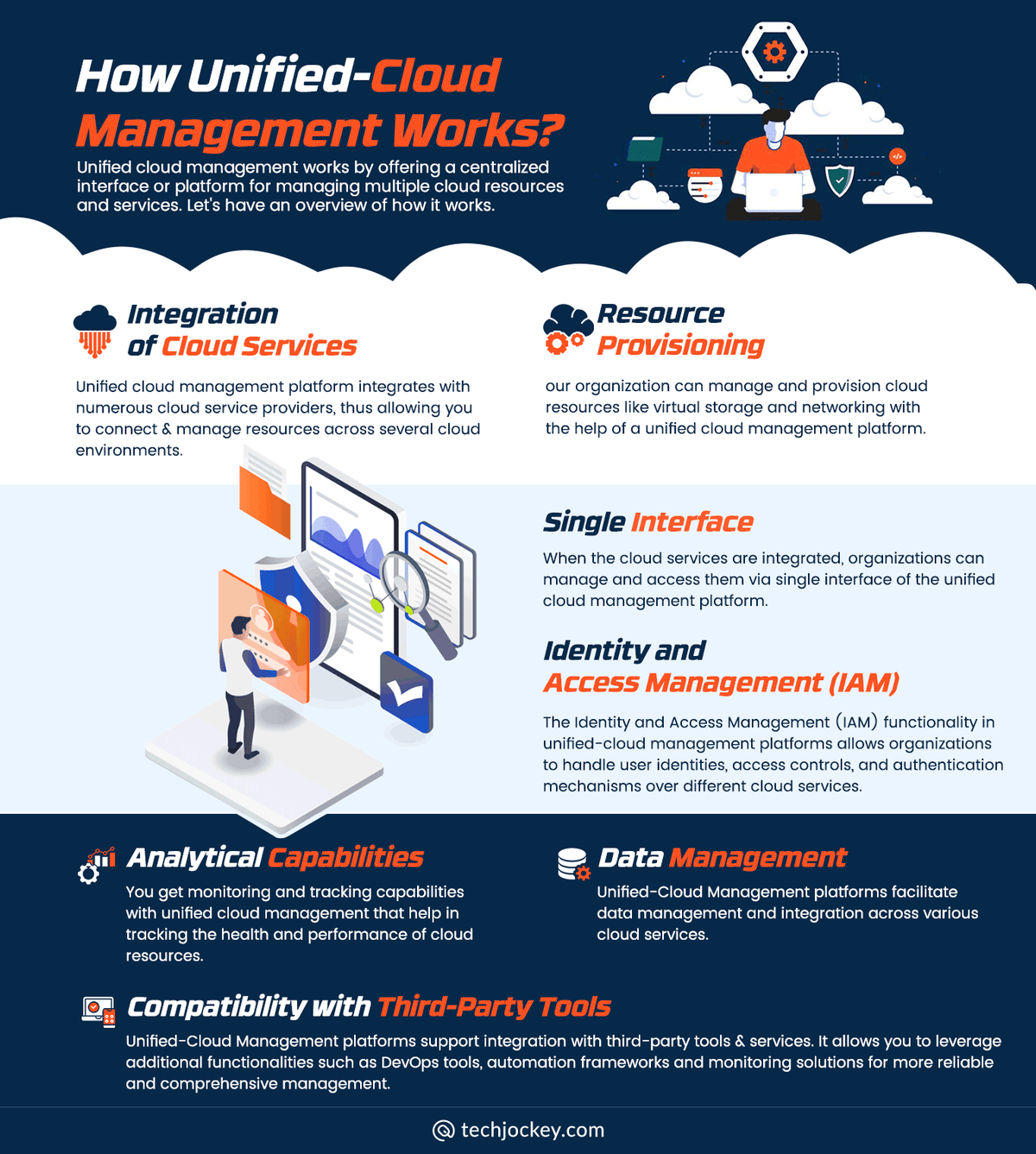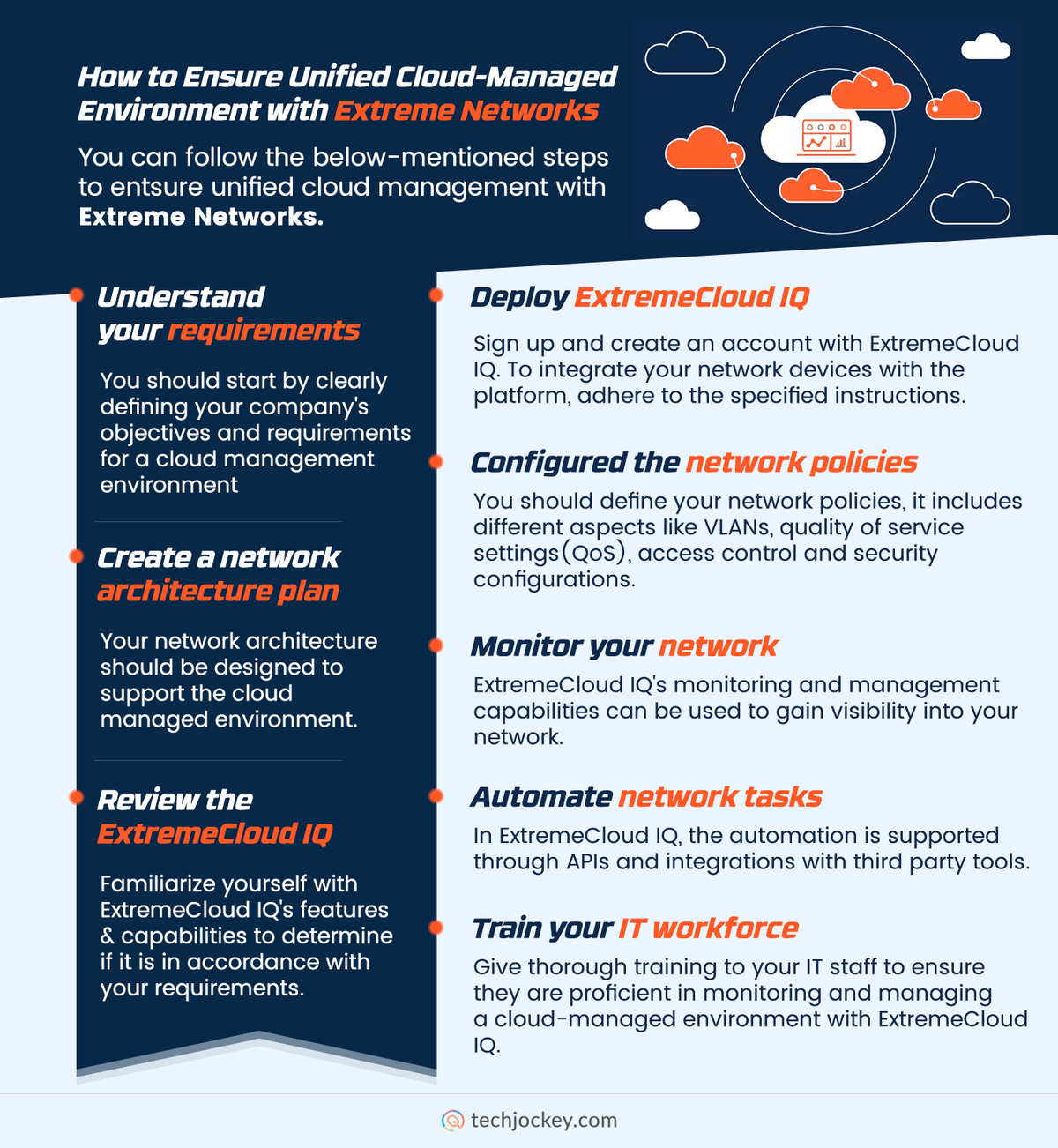5 Ways to Ensure a Unified Cloud-Managed Environment with Extreme Networks

Summary: Multi-cloud and hybrid cloud have made cloud governance more difficult than ever. Nowadays, it’s not unusual for a company’s cloud infrastructure to become disorganized. But companies can avoid risks by forming a robust cloud strategy and utilizing the right tools.
By using cloud management services, you can reduce management burdens and enforce effective practices and policies. This involves using clever and effective techniques to deliver cloud services through a single shared infrastructure.
What are Unified-Cloud Services?
Unified cloud services refer to a set of comprehensive cloud-based services that can combine numerous capabilities and functionalities into a single platform. Its main aim is to provide organizations with cohesive and seamless experiences across various aspects of cloud computing. It enables them to effectively manage and leverage a wide range of cloud services from a single interface.
By having a unified platform, organizations can automate workflows, optimize resource allocation, and improve the overall operational efficiency.
It eliminates the need for manual coordination and integration between different cloud services, leading to increased productivity. Owing to the unified nature of cloud services, you can seamlessly scale your applications and infrastructure.
Moreover, Unified-Cloud Services often come with robust security features and compliance frameworks. Through a single platform, you can implement consistent security measures, reduce compliance across cloud infrastructure and mitigate vulnerabilities and risks.
How Unified-Cloud Management Works?

Unified cloud-management works by offering a centralized interface or platform for managing multiple cloud resources and services. Let’s have an overview of how it works.
- Integration of Cloud Services: Unified cloud management platform integrates with numerous cloud service providers, thus allowing you to connect and manage resources across several cloud environments. This integration can be accomplished through Application Programming Interfaces (APIs) provided by cloud service providers.
- Resource Provisioning: Your organization can manage and provision cloud resources like virtual storage and networking with the help of a unified cloud-management platform. You can allocate the resources as per demand and scale as per requirement.
- Single Interface: When the cloud services are integrated, organizations can manage and access them via single interface of the unified cloud-management platform. This interface acts as a control panel, providing a comprehensive view of all available resources and services.
- Identity and Access Management (IAM): The Identity and Access Management (IAM) functionality in unified-cloud management platforms allows organizations to handle user identities, access controls, and authentication mechanisms over different cloud services. It provides centralized user management and ensures secured access to all resources.
- Analytical Capabilities: You get monitoring and tracking capabilities with unified cloud-management that help in tracking the health and performance of cloud resources. Moreover, you also get centralized logging, dashboard monitoring and alerts feature to proactively identify and resolve issues.
- Data Management: Facilitate data management and integration across various cloud services. You get features like data warehousing, data migration, and data integration to ensure seamless data flow between different cloud environments.
- Compatibility with Third-Party Tools: Support integration with third-party tools & services. It allows you to leverage additional functionalities such as DevOps tools, automation frameworks and monitoring solutions for more reliable and comprehensive management.
How to Ensure Unified Cloud-Management Environment with Extreme Networks?

You can follow the below-mentioned steps to ensure unified cloud-management with Extreme Networks.
- Understand your requirements: You should start by clearly defining your company’s objectives and requirements for a cloud management environment. Moreover, you must also consider factors like security, performance, integration and scalability with current infrastructure.
- Create a network architecture plan: Your network architecture should be designed to support the cloud managed environment. Identify the essential network components like access points, security appliances and switches. Plus, you should ensure that it is compatible with ExtremeCloud IQ, which is a cloud-based network management platform offered by Extreme Networks.
- Review the ExtremeCloud IQ: Familiarize yourself with ExtremeCloud IQ‘s features and capabilities to determine if it is in accordance with your requirements. Additionally, You can manage your entire network infrastructure with ExtremeCloud IQ’s unified interface.
- Deploy ExtremeCloud IQ: Sign up and create an account with ExtremeCloud IQ. To integrate your network devices with the platform, adhere to the specified instructions. Moreover, thanks to ExtremeCloud IQ, you can centrally control a variety of Extreme Networks hardware.
- Configured the network policies: You should define your network policies, it includes different aspects like VLANs, quality of service settings(QoS), access control and security configurations. Moreover, you must also ensure consistent policy enforcement across your network to maintain a unified network environment.
- Monitor your network: ExtremeCloud IQ’s monitoring and management capabilities can be used to gain visibility into your network. You can use the platform’s intuitive interface to monitor device health, network performance and security protocols. It allows proactive troubleshooting and optimization.
- Automate network tasks: In ExtremeCloud IQ, the automation is supported through APIs and integrations with third party tools. You must explore these capabilities to streamline network operations and ensure consistency. Moreover, you can also automate repetitive tasks such as configuration updates and device provisioning to mitigate human errors and save time.
- Train your IT workforce: Give thorough training to your IT staff to ensure they are proficient in monitoring and managing a cloud-managed environment with ExtremeCloud IQ. Familiarize them with the platform’s functionalities, features and best practices for seamless configuration, monitoring, and troubleshooting.
Conclusion
Cloud managed environment service offers complete or partial management of your cloud infrastructure or resources. Whether you have a hybrid or multi-tenant cloud environment, you can trust Extreme Network for the optimization, configuration, migration, security, and maintenance of your cloud infrastructure.
The company is backed by extensive knowledge of the entire cloud ecosystem that empowers you to seamlessly handle all complexities of Unified Cloud-Managed Environment services with aplomb.
Moreover, organizations across the globe have recognized the power of Extreme Networks as reliable enablers of innovation and digital transformation. Now, it is your turn to future-proof your business with the help of their reliable, secure, and faster cloud management solution.
Danish Jacob is a goal-driven and accomplished professional with over 8 years of work experience in Content Writing and Digital Marketing. He holds a degree in M.A.-(English Literature and Language) from Jaipur National University and currently pursuing an MBA in Marketing from Manipal University Jaipur. Owing to the... Read more




























